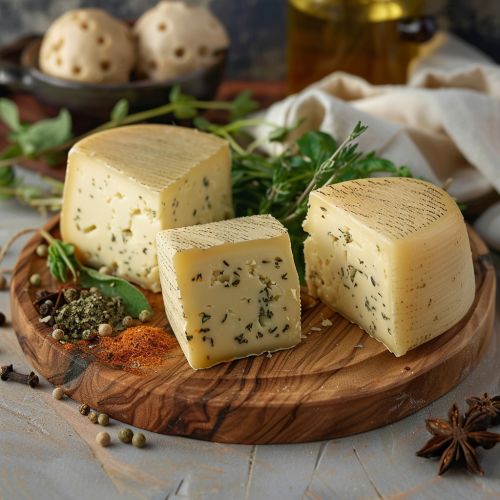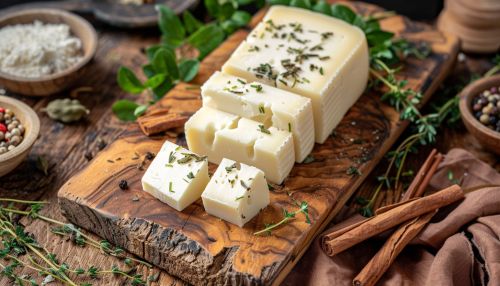Wara: Difference between revisions
(Created page with "== Introduction == Wara, a traditional cheese made from fresh cow's milk, is a staple in Nigerian cuisine and other West African countries. Known for its unique texture and flavor, Wara is often enjoyed as a snack or incorporated into various dishes. This article delves into the intricate details of Wara, exploring its historical background, production methods, nutritional profile, and cultural significance. == Historical Background == The origins of Wara can be traced...") |
No edit summary |
||
| Line 26: | Line 26: | ||
5. **Salting and Storing**: The cheese can be salted to taste and stored in a cool place until ready to be consumed. | 5. **Salting and Storing**: The cheese can be salted to taste and stored in a cool place until ready to be consumed. | ||
[[Image:Detail-91357.jpg|thumb|center|Freshly made Wara cheese on a wooden board, surrounded by herbs and spices.|class=only_on_mobile]] | |||
[[Image:Detail-91358.jpg|thumb|center|Freshly made Wara cheese on a wooden board, surrounded by herbs and spices.|class=only_on_desktop]] | |||
== Nutritional Profile == | == Nutritional Profile == | ||
Latest revision as of 15:41, 21 June 2024
Introduction
Wara, a traditional cheese made from fresh cow's milk, is a staple in Nigerian cuisine and other West African countries. Known for its unique texture and flavor, Wara is often enjoyed as a snack or incorporated into various dishes. This article delves into the intricate details of Wara, exploring its historical background, production methods, nutritional profile, and cultural significance.
Historical Background
The origins of Wara can be traced back to the Yoruba people of Nigeria, where it has been a part of the culinary tradition for centuries. The cheese is believed to have been developed as a way to preserve milk and provide a nutritious food source during periods of scarcity. Over time, Wara has become an integral part of the diet in many West African communities, transcending its humble beginnings to become a beloved delicacy.
Production Methods
The production of Wara involves a series of meticulous steps that transform fresh cow's milk into a soft, crumbly cheese. The process begins with the collection of fresh milk, which is then heated to a specific temperature to facilitate coagulation. A coagulant, typically derived from the leaves of the sodom apple plant (Calotropis procera), is added to the milk to induce curdling. The curds are then separated from the whey and pressed to remove excess moisture, resulting in the final product.
Ingredients
- Fresh cow's milk
- Coagulant (usually from sodom apple leaves)
- Salt (optional)
Equipment
- Large pot
- Cheesecloth or muslin
- Strainer
- Pressing weight
Step-by-Step Process
1. **Heating the Milk**: Fresh cow's milk is heated to approximately 40°C (104°F) to facilitate coagulation. 2. **Adding the Coagulant**: The coagulant, often an extract from sodom apple leaves, is added to the heated milk. The mixture is stirred gently and left to sit until curds form. 3. **Separating Curds and Whey**: The curds are separated from the whey using a strainer lined with cheesecloth or muslin. 4. **Pressing the Curds**: The curds are gathered in the cheesecloth and pressed with a weight to remove excess moisture. 5. **Salting and Storing**: The cheese can be salted to taste and stored in a cool place until ready to be consumed.


Nutritional Profile
Wara is a rich source of protein, calcium, and essential vitamins, making it a nutritious addition to the diet. The cheese is low in fat compared to other types of cheese, which makes it a healthier option for those looking to reduce their fat intake. Additionally, Wara contains beneficial probiotics that aid in digestion and promote gut health.
Macronutrients
- **Protein**: Wara is high in protein, which is essential for muscle repair and growth.
- **Fat**: The fat content in Wara is relatively low, making it suitable for those on low-fat diets.
- **Carbohydrates**: Wara contains minimal carbohydrates, primarily in the form of lactose.
Micronutrients
- **Calcium**: Essential for bone health and muscle function.
- **Phosphorus**: Works in conjunction with calcium to maintain bone health.
- **Vitamin B12**: Important for red blood cell formation and neurological function.
Cultural Significance
Wara holds a special place in the culinary traditions of West Africa. It is often served at social gatherings, festivals, and religious ceremonies. In Yoruba culture, Wara is not only a food item but also a symbol of hospitality and community. The cheese is frequently offered to guests as a gesture of goodwill and is incorporated into various traditional dishes, such as stews and soups.
Culinary Uses
Wara is a versatile ingredient that can be used in a variety of dishes. It can be eaten fresh, fried, or grilled, and is often added to soups, stews, and salads. The cheese's mild flavor and crumbly texture make it an excellent addition to both savory and sweet dishes.
Popular Dishes
- **Wara Stew**: A hearty stew made with Wara, tomatoes, onions, and spices.
- **Fried Wara**: Wara slices are fried until golden brown and crispy, often served with a dipping sauce.
- **Wara Salad**: Fresh Wara is crumbled over a bed of mixed greens and drizzled with a light vinaigrette.
Health Benefits
Consuming Wara offers several health benefits due to its rich nutritional profile. The high protein content supports muscle growth and repair, while the calcium and phosphorus contribute to strong bones and teeth. Additionally, the probiotics in Wara can improve digestive health and boost the immune system.
Economic Impact
The production and sale of Wara have significant economic implications for local communities in West Africa. Small-scale producers and vendors rely on Wara as a source of income, and the cheese is often sold in local markets and roadside stalls. The demand for Wara has also led to the development of small dairy farms, contributing to the agricultural economy.
Challenges and Sustainability
Despite its popularity, the production of Wara faces several challenges, including the availability of fresh milk and coagulants. Additionally, the traditional methods of production are labor-intensive and time-consuming. Efforts are being made to modernize the production process and improve sustainability, such as the use of alternative coagulants and the development of small-scale dairy cooperatives.
Conclusion
Wara is more than just a cheese; it is a cultural icon and a testament to the ingenuity of West African culinary traditions. Its unique flavor, nutritional benefits, and cultural significance make it a cherished food item in many communities. As efforts continue to modernize and sustain its production, Wara will likely remain a beloved staple for generations to come.
